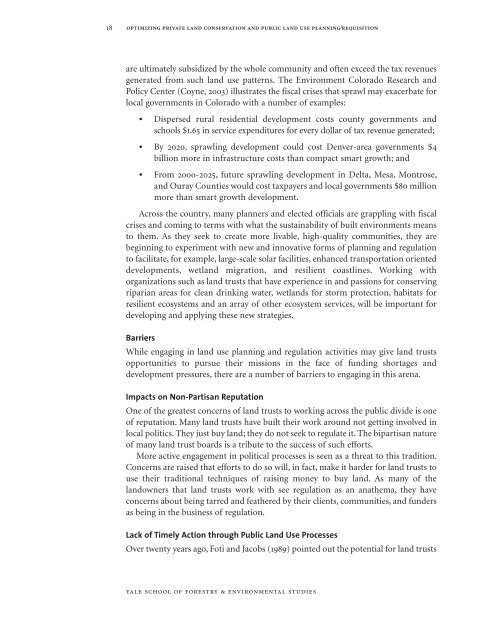Complete Report - Yale University
Complete Report - Yale University
Complete Report - Yale University
Create successful ePaper yourself
Turn your PDF publications into a flip-book with our unique Google optimized e-Paper software.
18OPTIMIZING PRIVATE LAND CONSERVATION AND PUBLIC LAND USE PLANNING⁄REQUISITIONare ultimately subsidized by the whole community and often exceed the tax revenuesgenerated from such land use patterns. The Environment Colorado Research andPolicy Center (Coyne, 2003) illustrates the fiscal crises that sprawl may exacerbate forlocal governments in Colorado with a number of examples:●Dispersed rural residential development costs county governments andschools $1.65 in service expenditures for every dollar of tax revenue generated;●By 2020, sprawling development could cost Denver-area governments $4billion more in infrastructure costs than compact smart growth; and●From 2000-2025, future sprawling development in Delta, Mesa, Montrose,and Ouray Counties would cost taxpayers and local governments $80 millionmore than smart growth development.Across the country, many planners and elected officials are grappling with fiscalcrises and coming to terms with what the sustainability of built environments meansto them. As they seek to create more livable, high-quality communities, they arebeginning to experiment with new and innovative forms of planning and regulationto facilitate, for example, large-scale solar facilities, enhanced transportation orienteddevelopments, wetland migration, and resilient coastlines. Working withorganizations such as land trusts that have experience in and passions for conservingriparian areas for clean drinking water, wetlands for storm protection, habitats forresilient ecosystems and an array of other ecosystem services, will be important fordeveloping and applying these new strategies.BarriersWhile engaging in land use planning and regulation activities may give land trustsopportunities to pursue their missions in the face of funding shortages anddevelopment pressures, there are a number of barriers to engaging in this arena.Impacts on Non-Partisan ReputationOne of the greatest concerns of land trusts to working across the public divide is oneof reputation. Many land trusts have built their work around not getting involved inlocal politics. They just buy land; they do not seek to regulate it. The bipartisan natureof many land trust boards is a tribute to the success of such efforts.More active engagement in political processes is seen as a threat to this tradition.Concerns are raised that efforts to do so will, in fact, make it harder for land trusts touse their traditional techniques of raising money to buy land. As many of thelandowners that land trusts work with see regulation as an anathema, they haveconcerns about being tarred and feathered by their clients, communities, and fundersas being in the business of regulation.Lack of Timely Action through Public Land Use ProcessesOver twenty years ago, Foti and Jacobs (1989) pointed out the potential for land trustsyale school of forestry & environmental studies
















